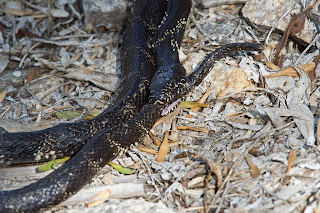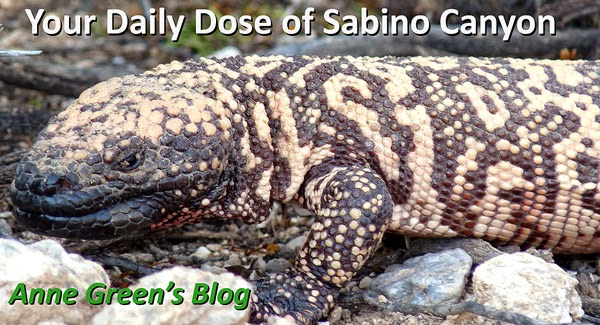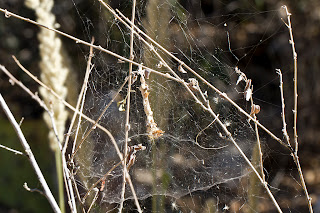| Photo by Carol Tornow |
Monday, October 31, 2011
Fruit of the vine
Sunday, October 30, 2011
Take a walk on the Ned side
 |
| Hooker's Evening Primrose All Photos by Ned Harris |
 |
| Button Bush |
 |
| Funereal Duskywing |
 |
| Ornate Tree Lizard |
Friday, October 28, 2011
Webs
Thursday, October 27, 2011
Calling all ant-o-philes
This post is again courtesy of Gerry. Some inquiring minds want to learn more and asked for his book recommendations. Gerry writes:
I would recommend (in this order):Thanks again to Gerry for sharing his keen observations of nature in all its glory.
1. Mark Moffett, Adventures among Ants.
2. Bert Hölldobler and Edward O. Wilson. The Leafcutter Ants: Civilization by Instinct.
3. Deborah Gordon. Ants At Work: How An Insect Society Is Organized.
4. Laurent Keller. The Lives of Ants.
The Pima County library system has 1, 2 and 3. I'd recommend 1 as the most engagingly-written of the four and has some spectacular photos. The second one is also fascinating, but of course only focuses on one type of ant. The third one is a slightly drier and gets far more into the "dig 'em up and see what makes 'em tick" kind of research that I don't particularly like (though the results are *sometimes* interesting). The fourth one is quite dry but nevertheless has its moments, especially in its summary of ant genetics and the subtle struggles that take place *within* ant colonies.
If you search Google for "mark moffett interview" there's an interview with Terry Gross on 'Fresh Air'. (Anne says: it's linked here.) It was the Terry Gross interview that inspired me to read Mark Moffett's book, and that book made me want to read more.
Wednesday, October 26, 2011
Ant War
Photos and text courtesy of Gerry Morgan (of the turkey vultures). All photos clickable.
I've been doing a lot of reading about ants since we had an "ant war" in our yard between two colonies. Fascinating stuff. It took 2-3 days to get resolved. The source of the dispute was that the (red) harvester ants (Pogonomyrmex maricopa) had a hole that emerged right between two holes belonging to the (black) long-legged ants (Aphenagaster cockerelli).
 |
| Note the smaller harvester ant hole in the center |
The harvester ants have very strong venom but are far less aggressive than the black ants, so the black ants tend to prevail.
In [the shot below], you can see a harvester being dragged down the black ants' hole. I imagine it was welcomed by a large, villainous ant saying, "Welcome to our nest, Mr Bond, have our soldiers made you comfortable?"
 |
| 007 is going down this time |
The photos show a quite spirited battle, but the odd thing was that most of the ants were not taking part. I feel rather like a news reporter who comes back from a mostly-peaceful event with photos that tend to suggest it was quite different.
 |
| Here, the harvester ants prevail |
I was reading a book about ants when all this happened and it inspired me to read a couple more.Anne asks: How about reading about, say, dinosaurs? When can we expect photos? Thanks, Gerry, for sharing this documentary.
Tuesday, October 25, 2011
It's really a dragonfly
 |
| Click on this great photo by Ned Harris, 10/8/11 |
Monday, October 24, 2011
Gimme a T
 |
| Photo by Ned Harris |
Another T is the answer to yesterday's quiz: Termites. They 'process' (poop out) the plant material as they go munching along. Talk to two termite tubes today!
Sunday, October 23, 2011
Quiz for Marge
Saturday, October 22, 2011
Bug and Moon
 |
| Photo by Ned Harris, 10/18/11 |
 |
| Another photo by Ned Harris, 10/18/11 c. 10.30am |
Thursday, October 20, 2011
And now a word (or two) from Fred
 |
| Photo by Ned Harris 10/18/11 |
(You'll want to click on the photo for a bigger view.) Ned asked Fred Heath for an i.d. on this butterfly, and Fred was happy to oblige. Some excerpts:
Very interesting photo!! The butterfly is a Ceraunus Blue (Hemiargus ceraunus) which somewhat resembles a Marine Blue with [fewer] and less obvious markings. It is nectaring on Dalea Dalea pringlei. This species is known to use various legumes as food plants (what the caterpillar eats), although I don’t know that a Dalea has been recorded as a food plant.Thanks, Fred
What is interesting is the fact that there is well camouflaged caterpillar in your photo which could well be a Ceraunus Blue. If you look just above and slightly to the right of the base of the flower you will see a slug-like creature which is off-white with brownish markings. I will send a copy of this photo to our local expert Jim Brock to ID if possible (it could be Marine or Reakirt’s Blue as well since they all look similar and usually are colored and patterned to match the host plant somewhat). I will let you what he thinks. [time passes...] After checking with Jim Brock, it looks like the caterpillar will have to remain a mystery blue. Since the caterpillars of these small blues look so similar, he says the only way to tell for sure is to raise the caterpillar to adulthood.
Wednesday, October 19, 2011
Now for some fauna
 |
| Photo by Ned Harris, 10/18/11 |
Tuesday, October 18, 2011
Getting at the root
| Both photos by Ellen Green 10/9/11 |
Monday, October 17, 2011
In the pink
| Photo by Ellen Green, 10/9/11 |
Sunday, October 16, 2011
Not for salad
| Photo by Carol Tornow |
Saturday, October 15, 2011
Friday, October 14, 2011
Tucked away
| Photo by Carol Tornow, 10/11/11 |
Thursday, October 13, 2011
Dogweed
| Photo by Carol Tornow, 10/11/11 |
This cute little plant is blooming all over; I saw some very fine specimens on E. Ocotillo Drive last week. (This photo comes from Sabino Canyon, of course.) It's called Dogweed or Five-needle Pricklyleaf (Thymophylla pentachaeta) and is (you guessed it) in the Sunflower Family (Asteraceae). The smile-inducing flowers are no bigger than a dime.
Wednesday, October 12, 2011
Burro Brush and Burroweed contrast
| Photo by Carol Tornow, 10/11/11 |
This post is for you, Bryna!
Tuesday, October 11, 2011
Arizona (Black) Walnut Update
| Photo by Peggy Wenrick, 10/10/11 |
Monday, October 10, 2011
The odor of Odora
| Photo by Ellen Green, 10/9/11 |
Sunday, October 9, 2011
New Snake (for us, anyway)
| Photos by Ellen Green, 10/9/11 |
Saw this c. 4-foot long snake on the Esperero Trail. Ellen was quick enough with her camera to catch the head. The rest was the same color and pattern. Looking through the possibilities on the Reptiles of Arizona site, I've identified it as a Sonoran Whipsnake. Hope you agree.
Saturday, October 8, 2011
Not a hawk
 |
| Photo by Ned Harris, 10/8/11 |
If you said: Golden-flowered Agave aka Century Plant (Agave chrysantha), you get an A for Agave on yesterday's photo quiz.
Friday, October 7, 2011
Now in the Asparagus Family near you!
| Photo by Carol Tornow |
Thursday, October 6, 2011
Get out your calendar!
It's time again for family and friends to flock to Tucson. If you are looking for something to do with loved ones in Sabino Canyon, click for the schedule of FREE (after you get into the recreation area, that is. But you can cough up $5 for your loved ones, right?) FREE activities brought to you by the Sabino Canyon Volunteer Naturalists. Interested in a Friday hike? Take a look here.
And don't forget to take photos (and send them to me for this blog : -)
And don't forget to take photos (and send them to me for this blog : -)
Wednesday, October 5, 2011
Tuesday, October 4, 2011
Another dainty blossom
| Photo by Carol Tornow, 9/23/2011 |
| Photo by Matt Ball, Sept 2010 |
Chiricahua Mountain Sandmat (Euphorbia florida) is in the Euphorbiaceae (Spurge) Family. The flowers are very tiny, sometimes have a pink tinge. Look low to the ground.
Monday, October 3, 2011
Praying Mantis female
| Photos by Matt Ball, 10/1/11 |
While watering this Desert Marigold in my backyard on Saturday morning, I 'caught' this praying mantis putting the finishing touches on her egg casing. As of Sunday evening, 'mom' is still hanging around that plant. (You'll note it's directly in front of the heat pump.) Wouldn't it be neat if we could witness the 'hatching'?
Sunday, October 2, 2011
Scarlet Creeper
 |
| Photos by Ned Harris, 9/25/11 |
 |
| Close up of Scarlet Creeper |
Saturday, October 1, 2011
Not so regal after all
 |
| Photos by Ned Harris |
 |
| Click to see tail biting |
Ned Harris posted photos of this Common Kingsnake to his flickr site recently and Angie Perryman was curious enough about the tail-biting behavior to ask a snake expert in town what was going on. Here is his reply:
"Kingsnakes rely heavily on chemical queues when it comes to feeding. They don't see very well. I keep one, and come feeding time, it will often bite and constrict itself. All while the prey item is dancing on its head. It has often bit its own tail as part of the process. He has a permanent scar from doing that. One fine day, it will likely eat itself from the tail up, leave a zinger for me to clean up, and I can be rid of the darn thing. They really are STOOPID snakes. The snake pictured is emaciated, and hungry. I expect that it got wind of another prey item, likely a snake. [Anne notes: maybe it was this same snake.] It confused the scent with its own tail, and started chewing on that. I saw all the pictures that Mr. Harris put up. It's hard for me to determine how long he stayed with it, or what the outcome was. It looks like the snake finally figured out that its own tail was not the prey item it was seeking, but again, I wasn't there. [Anne notes: Ned stayed around for about 10 minutes of tail-biting.] That's my $0.02 worth. Feel free to post my comment. I'm pretty sure it's the right explanation for the reason behind it all. Best, Roger"Thanks Ned, Angie, and Roger for enlightening us on Kingsnake behavior!
Subscribe to:
Posts (Atom)





